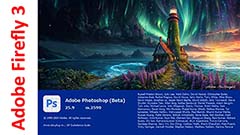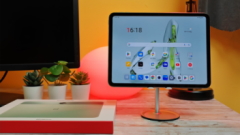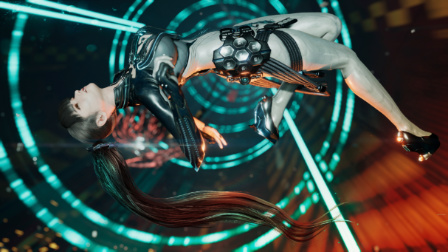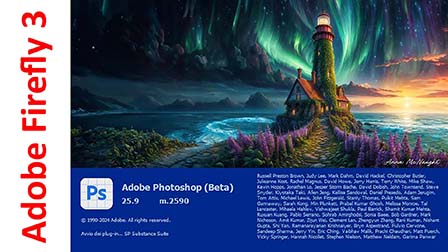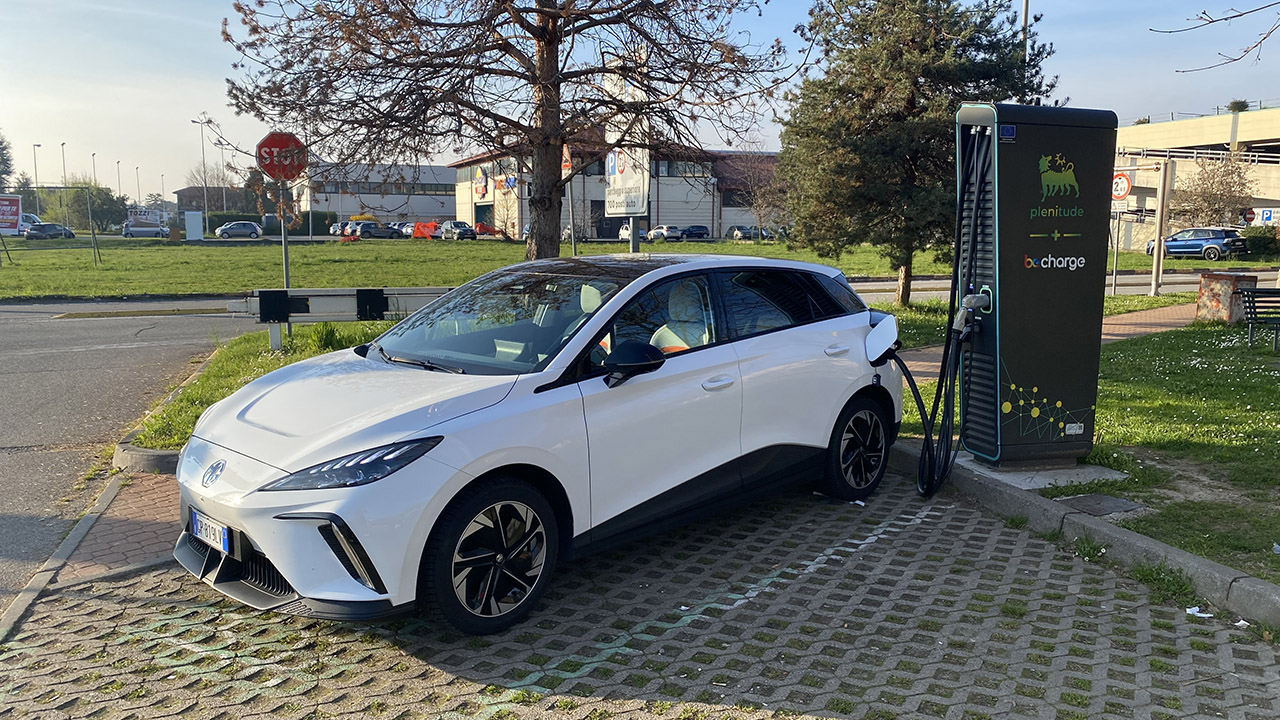|
|||||||
|
|
|
 |
|
|
Strumenti |
|
|
#221 |
|
Senior Member
Iscritto dal: Nov 2001
Città: Padova
Messaggi: 1635
|
Spirit rover establishes new Mars driving record
BY JUSTIN RAY SPACEFLIGHT NOW Posted: February 10, 2004 The rover Spirit drove into the Martian history books Monday night by making the longest single-day traverse on the Red Planet, eclipsing the mark set by Mars Pathfinder's Sojourner rover in 1997. Spirit cruised 69.6 feet (21.2 meters), shattering Sojourner's record of 23 feet (7 meters).  From Spirit's rear-looking camera, the rover's wheel tracks and lander base are visible during driving on Monday night. Credit: NASA/JPL "The basic goal was drive as far as they could and see how things went in the time they had. They did very well," mission manager Jim Erickson said of the Spirit rover controllers. "They used two different types of drives. A blind drive -- a pre-planned with no hazardous avoidance turned on -- for 13 meters. And then they performed a drive with a go-to waypoint." That second drive instructed the rover to drive from one point to another on its own, making a turn autonomously. "Everything seemed to go fine there," Erickson said. Spirit is headed for a large crater in the distance called Bonneville. Exactly how long it will take to reach the target isn't known, but engineers hope the amount of driving will increase each day. "Tomorrow's plan is further driving. The day after that is driving even further," Erickson said. "I expect we are going to start out kind of slow -- although 21.2 meters is not that slow -- and built up as we get more experience in long-term driving." Spirit began roving late Sunday, leaving behind the first rock it examined. The craft moved 21 feet (6.4 meters), and simply drove over the pyramid-shaped Adirondack. The rover spent several weeks parked in front of Adirondack as the science instruments examined the rock, determining the mineral and elemental composition. The Rock Abrasion Tool then carved a small hole into Adirondack to remove the outer surface. "It's really opened up a window into the interior of this (rock) that we can use to understand this rock really well," lead scientist Steve Squyres said. With the cutting complete, the Microscopic Imager, Alpha Particle X-Ray Spectrometer and Mossbauer Spectrometer instruments then examined the RAT hole.  This close-up image taken by the Microscopic Imager onboard Spirit shows Adirondack after a portion of its surface was ground off by the rover's Rock Abrasion Tool. The observed area is 3 centimeters (1.2 inches) across. Credit: NASA/JPL/Cornell/USGS "What you are seeing there is a beautifully cut, almost polished rock surface," Squyres said, referring to the microscopic image. "It looks very, very much like -- in the image -- a volcanic rock, a basalt. And, in fact, when we look at this with the APXS and Mossbauer, we find compelling compositional evidence that, in fact, what we are looking at is a volcanic basaltic rock. "So the RAT has revealed the interior of this rock. We know what it is -- a piece of volcanic stuff. And it is time to move on."
__________________
Cosmos Pure | Core i7 860 | P7P55D-E Deluxe | 16GB DDR3 Vengeance | HD5850 | 2x850PRO 256GB | 2xRE3 250GB | 2xSpinPoint F3 1TB |
|
|

|
|
|
#222 |
|
Senior Member
Iscritto dal: Nov 2001
Città: Padova
Messaggi: 1635
|
Cold motor causes Spirit to remain parked for a day
BY JUSTIN RAY SPACEFLIGHT NOW Posted: February 11, 2004 A missed communications window caused by a cold antenna motor on the Mars Exploration Rover Spirit prevented the robot from racking up any additional distance on its odometer Tuesday night. "Yesterday was an operational issue day with Spirit. We did not get the morning high-gain antenna pass. As a result of that, we did not get sequences loaded up (into the rover)," project manager Pete Theisinger told reporters in a teleconference today.  Spirit has remained parked since its Monday night workday. It will examine the dune features to its left before continuing to the Bonneville Crater. Credit: NASA/JPL As the Sun rose for the start of Spirit's 38th workday on Mars, the Pancam Mast Assembly was creating a shadow on the high-gain antenna gimbal motors. The motors have heaters to ensure they are warm enough to move. But the cold temperatures in the shadow were too great for the heaters to overcome, causing the motors to stall when trying to point the lollipop-shaped antenna to face Earth. "The colder you get, the more current you have put into the motors to get it to move. So we set those limits. Because we were in the shade, we did not set high enough current limits for the motors," Theisinger explained. "When we first started to do the high-gain antenna session yesterday, we started out by going to a (calibration), which goes to a hard-stop. The way the motor knows it has gone to the hard-stop is it stalls against the hard-stop. Because we had set the current limits so low, it stalled immediately, thought it was at the hard-stop. Then when it continued on with its high-gain antenna session, it was pointed off in a different direction than we expected. So we got no data down. "We did a high-gain antenna session later in the day when things had warmed up. That went just fine. We looked at all of the telemetry, and everything is just perfect. It was just this failure to understand that we are going to run cold in the morning and we need to either wait till later in the day when the shadow left the actuators or apply more heat with the heater we have. "We've taken steps to fix that operationally now so we don't have those issues in the future." Without having the high-gain antenna session in the morning, controllers weren't able to load the day's driving commands into the rover. "That situation plus diagnosing what situation we had and making sure we were really okay took all of the day. So they chose not to drive yesterday," Theisinger said. Once the communications trouble began, controllers began troubleshooting to narrow the possible cause. "You really don't try and prejudge until you get to the end of the story," Theisinger said. "They got a beep from the low-gain (antenna) and that told them the sequence didn't get in, and it also told them that at least at the time of the beep the telecommunications channel was working just fine. And so they thought maybe they had a high-gain antenna pointing problem. "They commanded a low-gain session and they got that, and so they knew once again the telecommunications was fine. And that comes down with a whole bunch of fault information, which said we were not in fault protection and there were not fault responses running. So that was a whole bunch of good news. The question then became why did the high-gain antenna session not happen?" Engineers determined the problem had to be a mis-pointing of the high-gain antenna. Since the rover was not in X-band fault, Spirit didn't know the antenna was facing the wrong direction. In addition, controllers determined that Spirit had marked all of the telemetry as sent, meaning the craft thought it had completed a communications session with Earth using the antenna. "That got them pretty much focusing on thermal pretty quickly. So I don't think they were too alarmed as they walked through the possible scenarios. They got on the trail pretty quickly." On the upcoming Sol 39 workday at begins Wednesday evening (U.S. time), Spirit will snap microscopic imaging of tiny dunes to its left and then drive upwards of 25 meters on its continuing trek to Bonneville Crater. Meanwhile, the Opportunity rover remains healthy as it drives along the bedrock outcropping, taking imagery and science data.
__________________
Cosmos Pure | Core i7 860 | P7P55D-E Deluxe | 16GB DDR3 Vengeance | HD5850 | 2x850PRO 256GB | 2xRE3 250GB | 2xSpinPoint F3 1TB |
|
|

|
|
|
#223 |
|
Senior Member
Iscritto dal: Apr 2000
Messaggi: 425
|
__________________
http://www.cipoo.net Musica corale di pubblico dominio - spartiti-MID-MP3 Chi cerca conferme le trova sempre. (Popper) |
|
|

|
|
|
#224 |
|
Senior Member
Iscritto dal: Nov 2001
Città: Padova
Messaggi: 1635
|
Commercial Software Aided Reboot on Mars
By MATTHEW FORDAHL ALAMEDA, Calif. - It's a PC user's nightmare: You're almost done with a lengthy e-mail, or about to finish a report at the office, and the computer crashes for no apparent reason. It tries to restart but never quite finishes booting. Then it crashes again. And again. Getting caught in such a loop is frustrating enough on Earth. But imagine what it's like when the computer is more than 100 million miles away on Mars. That's what mission controllers faced when the Mars rover Spirit stopped communicating last month. Ultimately, the fix that saved Spirit wasn't that different from how a PC would be repaired on Earth. It's just that the folks who have their hardware on Mars _ and the eyes of the world on them _ are better prepared for disaster. Tech support for an $820 million mission is a cautious affair. Tools to recover from and fix any problem must be built into the system before launch. The systems' behaviors need to be completely understood and predictable. "Luckily, during the design period, we anticipated that we might get into a situation like this," said Glenn Reeves, who oversees the software aboard the Mars rovers Sprit and Opportunity at NASA's Jet Propulsion Laboratory. For stability, reliability and predictability, mission designers did not bust the budget and design the hardware or software from scratch. Instead, they turned to hardware and software that's been used in space before and has a proven track record on Earth as well. "The advantage of using commercial software is it's well-known, and it's well deployed," said Mike Deliman, an engineer at Alameda-based Wind River Systems Inc., which made the rovers' operating system. "It has been used throughout the world in hundreds of thousands of applications." The operating system, VxWorks, has its roots in software developed to help Francis Ford Coppola gain more control over a film editing system. But the developers, David Wilner and Jerry Fiddler, saw a greater potential and eventually formed Wind River, named for the mountains in Wyoming. VxWorks became a formal product in 1987. The operating system is embedded in systems that control jetliners and atomic colliders, anti-lock braking systems in cars and even heart pacemakers. It's also been used successfully in the Mars Pathfinder lander, Mars Odyssey orbiter and Stardust comet probe. "These are all things that can't afford to fail," Deliman said. A key advantage VxWorks has over Microsoft Corp.'s Windows or the Unix operating system is that it is nimble enough to react quickly to any scenario that might crop up. "If your heart beat goes irregular, you don't want it to take five minutes to figure out that your heartbeat has gone irregular," Deliman said in his office filled with computers, an empty fish tank and a few dog toys. "You want to be able to catch it right off the bat." That's simply not available yet in Windows or Unix. "I'm sure you've done things with Windows and perhaps gone off to go get a drink in the fridge, made a sandwich and come back and it's still waiting," Deliman said. "It's similar to Unix. Unix can take its sweet time about getting back to you what you want it to do." VxWorks operates within only 32 megabytes of random access memory, and parts of it can be modified remotely without having to restart the entire system. (Windows users also can have fixes automatically sent, but restarts are very often required.) VxWorks also can be tweaked to accommodate different hardware, said Deliman, who started working with JPL while Pathfinder was under development in 1994. In the rovers, the hardware is a single-board computer called the RAD6000. It was originally developed in the early 1990s by a division of IBM Corp., Air Force Research Labs and NASA's JPL. It's now owned by BAE Systems Inc., of Manassas, Va. The RAD6000, except for its protection from radiation, is similar to IBM's RS6000 server, which was popular among businesses in the 1990s. Its processor is a predecessor of the PowerPC, used in Apple Computer Inc.'s Macintosh computers since 1994. Today, there are 145 RAD6000s running on 77 satellites in space, said Vic Scuderi, manager of space programs at BAE Systems. It's so reliable, there's only one running on each rover. Like VxWorks, it was used aboard Mars Pathfinder and Stardust. The computer, which costs up to $300,000, runs at a fraction of the speed of today's desktop computers. It also has other limits, such as just 128 megabytes of random access memory. But Spirit and Opportunity carry more flash memory _ the same type used in digital cameras to store pictures _ than any other spacecraft. That turned out to be part of the problem that temporarily halted Sprit in its tracks. All computers, through the operating system, need to keep track of their files, whether they're on a hard disk or, as in the case of the rovers, in flash memory. And each file requires a little bit of memory. After seven months of cruising between Earth and Mars as well as a couple weeks on the ground, thousands of files accumulated in flash memory, quickly gobbling up the 32 megabytes allocated for the operating system. After more than two weeks on the ground, Spirit's computer reset itself. Over and over again. From the perspective of controllers on Earth, the device just stopped communicating. Each time it tried to load its software, it maxed out the available memory, triggering an alarm and another reset. Eventually, the batteries drained, a scenario that activated a setting similar to "Safe Mode" on Windows PCs, where only essential files are loaded at startup. "When it came up in this diagnostic mode, we started bringing back data, and that's when we figured out what really happened," Deliman said. Engineers acknowledged that the problem could have been caught in preflight testing, though that would have slowed development of a program already on a tight schedule. "Consuming all the memory in this vehicle is what we consider to be a very severe error," JPL's Reeves acknowledged. "The software actually behaved exactly as we expected it to."
__________________
Cosmos Pure | Core i7 860 | P7P55D-E Deluxe | 16GB DDR3 Vengeance | HD5850 | 2x850PRO 256GB | 2xRE3 250GB | 2xSpinPoint F3 1TB |
|
|

|
|
|
#225 |
|
Senior Member
Iscritto dal: Oct 2000
Città: UK
Messaggi: 7408
|
Molto interessante...
Mi chiedevo una cosa: quanto è previsto che sia il tempo di durata della missione?
__________________
"Questo forum non è un fottuto cellulare quindi scrivi in italiano, grazie." (by Hire) Le mie foto su Panoramio - Google Earth |
|
|

|
|
|
#226 | |
|
Senior Member
Iscritto dal: Sep 2001
Città: de_legato
Messaggi: 792
|
Quote:
__________________
---------------------------------------------- File reality.sys corrupted, Reboot Universe? Y/N ---------------------------------------------- |
|
|
|

|
|
|
#227 | |
|
Senior Member
Iscritto dal: Nov 2001
Città: Padova
Messaggi: 1635
|
Quote:
__________________
Cosmos Pure | Core i7 860 | P7P55D-E Deluxe | 16GB DDR3 Vengeance | HD5850 | 2x850PRO 256GB | 2xRE3 250GB | 2xSpinPoint F3 1TB |
|
|
|

|
|
|
#228 | |
|
Senior Member
Iscritto dal: Oct 2000
Città: UK
Messaggi: 7408
|
Quote:
__________________
"Questo forum non è un fottuto cellulare quindi scrivi in italiano, grazie." (by Hire) Le mie foto su Panoramio - Google Earth |
|
|
|

|
|
|
#229 | |
|
Senior Member
Iscritto dal: Nov 2000
Città: Sospeso nell'incredibile
Messaggi: 828
|
Quote:
 |
|
|
|

|
|
|
#230 | |
|
Senior Member
Iscritto dal: Nov 2001
Città: Padova
Messaggi: 1635
|
Quote:
__________________
Cosmos Pure | Core i7 860 | P7P55D-E Deluxe | 16GB DDR3 Vengeance | HD5850 | 2x850PRO 256GB | 2xRE3 250GB | 2xSpinPoint F3 1TB |
|
|
|

|
|
|
#231 | |
|
Senior Member
Iscritto dal: Oct 2000
Città: UK
Messaggi: 7408
|
Quote:
__________________
"Questo forum non è un fottuto cellulare quindi scrivi in italiano, grazie." (by Hire) Le mie foto su Panoramio - Google Earth |
|
|
|

|
|
|
#232 | |
|
Senior Member
Iscritto dal: Oct 2000
Città: UK
Messaggi: 7408
|
Quote:
__________________
"Questo forum non è un fottuto cellulare quindi scrivi in italiano, grazie." (by Hire) Le mie foto su Panoramio - Google Earth |
|
|
|

|
|
|
#233 | |
|
Senior Member
Iscritto dal: Nov 2001
Città: Padova
Messaggi: 1635
|
Quote:
Il problema non è il funzionamento di notte, di notte non viene fatto lavorare il rover.. il problema è che se le batterie non hanno la carica entro una soglia minima, il sistema di riscaldamento non riesce a mantenere la temperatura interna del WEB entro le soglie di funzionamento dei componenti elettronici.
__________________
Cosmos Pure | Core i7 860 | P7P55D-E Deluxe | 16GB DDR3 Vengeance | HD5850 | 2x850PRO 256GB | 2xRE3 250GB | 2xSpinPoint F3 1TB |
|
|
|

|
|
|
#234 |
|
Senior Member
Iscritto dal: Nov 2001
Città: Padova
Messaggi: 1635
|
2245 GMT (5:45 p.m. EST)
Latest report from Mission Control: NASA's Mars Exploration Rover Opportunity has scooped a trench with one of its wheels to reveal what is below the surface of a selected patch of soil. "Yesterday we dug a nice big hole on Mars," said Jeffrey Biesiadecki, a rover planner at NASA's Jet Propulsion Laboratory, Pasadena, Calif. The rover alternately pushed soil forward and backward out of the trench with its right front wheel while other wheels held the rover in place. The rover turned slightly between bouts of digging to widen the hole. "We took a patient, gentle approach to digging," Biesiadecki said. The process lasted 22 minutes. The resulting trench -- the first dug by either Mars Exploration Rover -- is about 50 centimeters (20 inches) long and 10 centimeters (4 inches) deep. "It came out deeper than I expected," said Dr. Rob Sullivan of Cornell University, Ithaca, N.Y., a science-team member who worked closely with engineers to plan the digging. Two features that caught scientists' attention were the clotty texture of soil in the upper wall of the trench and the brightness of soil on the trench floor, Sullivan said. Researchers look forward to getting more information from observations of the trench planned during the next two or three days using the rover's full set of science instruments. Opportunity's twin rover, Spirit, drove 21.6 meters closer to its target destination of a crater nicknamed "Bonneville" overnight Monday to Tuesday. It has now rolled a total of 108 meters (354 feet) since leaving its lander 34 days ago, surpassing the total distance driven by the Mars Pathfinder mission's Sojourner rover in 1997. Spirit has also begun using a transmission rate of 256 kilobits per second, double its previous best, said JPL's Richard Cook. Cook became project manager for the Mars Exploration Rover Project today when the former manager, Peter Theisinger, switched to manage NASA's Mars Science Laboratory Project, in development for a 2009 launch. Spirit's drive toward "Bonneville" is based on expectations that the impact that created the crater "would have overturned the stratigraphy and exposed it for our viewing pleasure," said Dr. Ray Arvidson of Washington University in St. Louis, deputy principal investigator for the rovers' science instruments. That stratigraphy, or arrangement of rock layers, could hold clues to the mission's overriding question -- whether the past environment in the region of Mars where Spirit landed was ever persistently wet and possibly suitable for sustaining life. Both rovers have returned striking new pictures in recent days. Microscope images of soil along Spirit's path reveal smoothly rounded pebbles. Views from both rovers' navigation cameras looking back toward their now-empty landers show the wheel tracks of the roversÕ travels since leaving the landers. Each martian day, or "sol" lasts about 40 minutes longer than an Earth day. Opportunity begins its 25th sol on Mars at 10:59 p.m. Tuesday, PST. Spirit begins its 46th sol on Mars at 11:17 a.m. Wednesday, Pacific Standard Time. The two rovers are halfway around Mars from each other.
__________________
Cosmos Pure | Core i7 860 | P7P55D-E Deluxe | 16GB DDR3 Vengeance | HD5850 | 2x850PRO 256GB | 2xRE3 250GB | 2xSpinPoint F3 1TB |
|
|

|
|
|
#235 |
|
Senior Member
Iscritto dal: Nov 2001
Città: Padova
Messaggi: 1635
|
Road trip to Bonneville Crater continues for Spirit
BY JUSTIN RAY SPACEFLIGHT NOW Posted: February 17, 2004 Proving to be a real Mars hotrod, the Spirit rover has become the most traveled vehicle on the Red Planet, surpassing the distance accumulated by the Pathfinder rover nearly seven years ago. "We certainly knew that was likely to occur, but it is good to see that it did after about 45 days on the surface," Richard Cook, the newly named Mars Exploration Rover project manager, said Tuesday. Pete Theisinger, project chief for the past few years, has been selected to manage NASA's nuclear-powered Mars Science Laboratory mission scheduled for launch in 2009.  Spirit looking behind as its empty lander base and the tracks across the Martian surface. Credit: NASA/JPL Spirit drove 21.6 meters (70.9 feet) to the north-northeast on Monday night (U.S. time), pushing its odometer to 108 meters (354 feet). The tiny Sojourner rover racked up 102 meters during its mission in 1997. Spirit is heading to the impact crater nicknamed by scientists as Bonneville. Along the way, the rover is stopping to collect science data on rocks, tiny dunes and soil samples across the wind-swept Martian surface. "We are doing robotic field geology," says Ray Arvidson, deputy principal investigator. "We are in the middle of a long set of drives with traverse science where we have started at the landing site and we are moving up to the rim of Bonneville Crater." Mission officials elected to dispatch Spirit to the crater with the goal of studying rock layers and obtaining information about the planet's history, including the potential of a watery past. "The idea is the impact crater would have overturned the stratigraphy and exposed it for our viewing pleasure," Arvidson said.  This mosaic image from Spirit's panoramic camera shows a forward-looking view. Credit: NASA/JPL/Cornell Spirit is expected to reach Bonneville in a couple of weeks, but the exact timeline depends on the amount of science activities performed en route. "It depends on what we find between where we are now and where we are going. We are looking for new materials to stop and to make detailed measurements of," Arvidson said. "The focus is on the traverse science and getting to the rim of Bonneville over the next dozen or so sols (Martian days). We should get there expeditiously. The rate at which we get there depends on what we discover in terms of new materials. Then once we are on the rim and finish making measurements, then the issue becomes can we get into the crater? What are the slopes of the walls? Or should we head for the Southeast Hills?"
__________________
Cosmos Pure | Core i7 860 | P7P55D-E Deluxe | 16GB DDR3 Vengeance | HD5850 | 2x850PRO 256GB | 2xRE3 250GB | 2xSpinPoint F3 1TB |
|
|

|
|
|
#236 |
|
Senior Member
Iscritto dal: Oct 2000
Città: UK
Messaggi: 7408
|
 Spirit Keeps Rollin' This 360-degree mosaic panorama image, taken by the navigation camera on the Mars Exploration Rover Spirit, includes a view of the lander. The lander is located to the south-southwest of the rover, which is moving toward a crater nicknamed "Bonneville. Sleepy Hollow can be seen to the right of the lander. As of Sol 44, which ended on February 17, 2004, the rover had moved a total of 106.6 meters (350 feet) since leaving the lander on January 15, 2004. This image was taken on Sol 39 (February 11, 2004).  Spirit Spies "Bonneville" This mosaic image from the panoramic camera on the Mars Exploration Rover Spirit shows the area in front of the rover after its record 27.5 meters (90.2 feet) drive on Sol 43, which ended February 16, 2004. Spirit is looking toward one of its future targets, the rim of a crater nicknamed "Bonneville."  Mark of the Moessbauer This image, taken by an instrument called the microscopic imager on the Mars Exploration Rover Spirit, reveals an imprint left by another instrument, the Moessbauer spectrometer. The imprint is at a location within the rover wheel track named “Middle of Road.” Both instruments are located on the rover’s instrument deployment device, or “arm.” Not only was the Moessbauer spectrometer able to gain important mineralogical information about this site, it also aided in the placement of the microscopic imager. On hard rocks, the microscopic imager uses its tiny metal sensor to determine proper placement for best possible focus. However, on the soft martian soil this guide would sink, prohibiting proper placement of the microscopic imager. After the Moessbauer spectrometer's much larger, donut-shaped plate touches the surface, Spirit can correctly calculate where to position the microscopic imager. Scientists find this image particularly interesting because of the compacted nature of the soil that was underneath the Moessbauer spectrometer plate. Also of interest are the embedded, round grains and the fractured appearance of the material disturbed within the hole. The material appears to be slightly cohesive. The field of view in this image, taken on Sol 43 (February 16, 2004), measures approximately 3 centimeters (1.2 inches) across.
__________________
"Questo forum non è un fottuto cellulare quindi scrivi in italiano, grazie." (by Hire) Le mie foto su Panoramio - Google Earth |
|
|

|
|
|
#237 |
|
Senior Member
Iscritto dal: Oct 2000
Città: UK
Messaggi: 7408
|
Le metto più piccole le immagini?
__________________
"Questo forum non è un fottuto cellulare quindi scrivi in italiano, grazie." (by Hire) Le mie foto su Panoramio - Google Earth |
|
|

|
|
|
#238 | |
|
Senior Member
Iscritto dal: Nov 2001
Città: Padova
Messaggi: 1635
|
Quote:
 direi... no dai, per me è lo stesso...
__________________
Cosmos Pure | Core i7 860 | P7P55D-E Deluxe | 16GB DDR3 Vengeance | HD5850 | 2x850PRO 256GB | 2xRE3 250GB | 2xSpinPoint F3 1TB |
|
|
|

|
|
|
#239 |
|
Senior Member
Iscritto dal: Oct 2000
Città: UK
Messaggi: 7408
|
Vabbè il grande capo qui non risponde, per cui io le metto ancora di questa dimensione...
 The Trench Throws a Dirt Clod at Scientists This picture, obtained by the microscopic imager on NASA's Opportunity rover during sol 24, February 17 PST, shows soil clods exposed in the upper wall of the trench dug by Opportunity's right front wheel on sol 23. The clods were not exposed until the trench was made. The presence of soil clods implies weak bonding between individual soil grains. The chemical agent or mineral that causes the dirt to bind together into a clod, which scientists call the "bonding agent," is currently unknown. Moessbauer and alpha particle X-ray spectrometer measurements of this spot, planned for sol 25, might help explain the bonding, which would ultimately help the rover team understand how geological processes vary across the red planet. In any case, the bonds between soil grains here cannot be very strong because the wheel dug down through this layer with little trouble.  Spirit Does a "Jig" at Laguna Hollow This front hazard-avoidance image taken by the Mars Exploration Rover Spirit on sol 45 shows Spirit in its new location after a drive totaling about 20 meters (65.6 feet). The circular depression that Spirit is in, dubbed "Laguna Hollow," was most likely formed by a small impact. Scientists were interested in reaching Laguna Hollow because of the location's abundance of very fine, dust-like soil. The fine material could be atmospheric dust that has settled into the depression, or a salt-based material that causes crusts in the soils and coating on rocks. Either way, scientists hope to be able to characterize the material and broaden their understanding of this foreign world. To help scientists get a better look at the variations in the fine-grained dust at different depths, controllers commanded Spirit to "jiggle" its wheels in the soil before backing away to a distance that allows the area to be reached with the robotic arm. Spirit will likely spend part of sol 46 analyzing this area with the instruments on its robotic arm.  Spirit's Path to Bonneville Scientists created this overlay map by laying navigation and panoramic camera images taken from the surface of Mars on top of one of Spirit's descent images taken as the spacecraft descended to the martian surface. The map was created to help track the path that Spirit has traveled through sol 44 and to put into perspective the distance left to travel before reaching the edge of the large crater nicknamed "Bonneville." The area boxed in yellow contains the ground images that have been matched to and layered on top of the descent image. The yellow line shows the path that Spirit has traveled and the red dashed line shows the intended path for future sols. The blue circles highlight hollowed areas on the surface, such as Sleepy Hollow, near the lander, and Laguna Hollow, the sol 45 drive destination. Scientists use these hollowed areas - which can be seen in both the ground images and the descent image - to correctly match up the overlay. Field geologists on Earth create maps like this to assist them in tracking their observations. Credit: NASA/JPL/Cornell
__________________
"Questo forum non è un fottuto cellulare quindi scrivi in italiano, grazie." (by Hire) Le mie foto su Panoramio - Google Earth |
|
|

|
|
|
#240 | |
|
Senior Member
Iscritto dal: Oct 2000
Città: UK
Messaggi: 7408
|
Quote:
 Vabbè allora metto quelle piccolette...
__________________
"Questo forum non è un fottuto cellulare quindi scrivi in italiano, grazie." (by Hire) Le mie foto su Panoramio - Google Earth |
|
|
|

|

|
| Strumenti | |
|
|
Tutti gli orari sono GMT +1. Ora sono le: 18:01.









